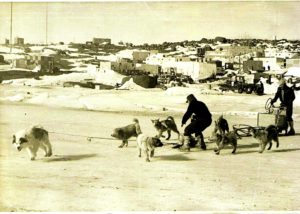Antarctic Sailing
At the Mawson Antarctic Base in 1963 there was a10 foot aluminium dinghy which was used for rowing out to small close-offshore islands for the maintenance of radio aerial towers. Most of the year the islands could be accessed on foot over the sea-ice but for about 2 or 3 months Mawson looked like a seaside village.
In previous years I had ocean raced and cruised in various yachts and had a yen to sail in the spectacular Mawson Bay, dotted with ice floes sometimes occupied by penguins and seals and ringed by ice cliffs which occasionally broke off with a tremendous crash and splash to form icebergs. So I set about making the dinghy sailable in what little spare time I had available.
Besides the employment for which we were paid, everyone had extra jobs as well as nightshift duty every 3 weeks and training to take over scientific jobs to relieve scientists’ routines when they were away on field trips. Nightshift was a constant patrol of the whole base, checking that the heaters were fuelled and setting up the ‘flaming fury’ lavatories but mainly watching out for accidental fire which was the most feared hazard in the Antarctic. I was employed as a weather observer on shift work and my main subsidiary job was to be responsible for the husky pack and to train the pups when they were born mid-year but until then I could squeeze in a few hours to devote to converting the dinghy into a sailing craft.
I was given access to the well-equipped carpentry workshop and the mechanics were generous enough to use their genius to make fittings for me out of scraps. They made fittings for a rudder to be swung on the stern and a gooseneck to fit to the mast for swivelling the boom. I found ropes and blocks for the running rigging and a damaged tent for the mainsail. There was plenty of wire rope for the standing rigging to which I spliced eyes for fixing to the gunwhales. There was not a pole long enough for a Bermuda-rig mast so it had to be a gaff rig. A centreboard was too challenging to fit so lee boards were substituted. I made these and the mast and gaff, rudder and tiller in the carpenter’s workshop.
The base OIC (Gaffer) was a yachty and reluctantly gave me permission to go ahead with the project when he heard about it. He was worried about the ramifications of a capsize in the freezing waters. The crew would be wearing layers of warm clothing which would make swimming ashore unlikely within the 3 minutes before lethal hypothermia set in. Then there was the katabatic winds that made a capsize somewhere between possible and probable. The katabatic wind is caused by dense cold air from the Antarctic plateau at an altitude of about 1500 metres rolling downhill on the steep slope to the sea. These winds can occur with little warning and turn into 150 km/hr blizzards within an hour. If we were blown out to sea the closest rescue vessel was thousands of miles away.
There was urgency to set sail before the bay froze over and at last we were ready to launch as the days became much shorter. Besides the Gaffer, there was no-one on the station with sailing experience but several novices were keen volunteers for their first sail. The Gaffer was not one of them and Alan won the toss
Launching day was sunny and relatively warm at minus 2 degrees C as Alan and I climbed aboard with most of the base crew watching. The wind was light and just enough for us to sail around the spectacular bay getting close to the towering ice cliffs and then around the radio masts on the islands. After about half an hour the wind freshened and Alan had to hang out over the side to keep us upright but that became more difficult as the wind became stronger so I tacked towards shore with wave tops splashing on board.
As we nudged the rocky shore there was a deep puddle in the bottom of the dinghy and we were quite damp but still exhilarated as the spectators gave us a cheer. The wind continued to strengthen, causing a big chill factor so we hurriedly de-rigged and turned the dinghy over and secured it to steel pegs fixed into the rock before going to our donga to dry and warm in front of the briquette-fuelled heater before heading to the mess for lunch.
Next day the Gaffer told me that our dinghy had been the first yacht in Antarctica because the word ‘yacht’ was Dutch and translated as ‘a sailing vessel used for pleasure’. He was sure no other vessel fitting that description had sailed in Antarctica before. I asked him what he meant by ‘had been’. He answered that the dinghy had blown away during the night. Now I know how to secure a dinghy to withstand a cyclone so I knew that if it had blown away someone had helped that happen and I suspected that it had been the Gaffer but I did not comment. He was responsible for the safety of everyone on the base and sailing down there definitely was hazardous.


Glad this didn’t happen during our sail.
https://youtu.be/hC3VTgIPoGU